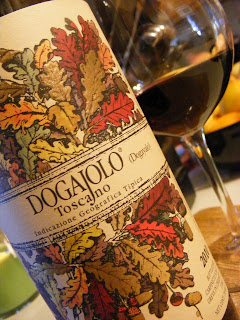What is a Super Tuscan:
The term is not an "official" term. I think it only came into use in the
1980's. Wine makers wanted to experiment with other grape varieties
as they did in California. Super Tuscan wines are Sangiovese blends with Cabernet Sauvignon and Merlot. These wines were outside the laws of the DOC/DOCG. These rules specify where the grapes must come from, what grapes must be used, sometimes how long they must be aged, in order to be called "Chianti" "Chianti Classico", etc. So they had to be labeled as Vino da Tavola (Table Wine, an official designation). Today, Vino da Tavola can be inexpensive table wine or wines that are outside of the current style and variety laws. Thus a high quality wine may carry this designation."Baby super Tuscan" is a young wine.
This is a very delicate wine. When first poured, not much happened, color was a dark red, in fact a bit darker than I expected. With a little persuasion, the wine opened up with the smell of roses and violets. On the palate delicate berry, spice, earth, smooth, silky tannins and a hint of olive with moderate acidity and a long to moderate finish. The floral of the Sangiovese and the spice of the Cabernet Sauvignon makes a delightful wine.
In order to understand the significance of Super Tuscan wines, we have to take a look at some history. Italy is a huge producer of wine. Wine in Italy is food. You drink it with breakfast, lunch and dinner. It is the culture. There is a wine making tradition that goes back thousands of years.
There are 20 regions and 96 provinces. The main regions are Piedmont, Tuscany and Veneto. The Denominazione di Origine Controllata (D.O.C.) controls the production and labeling of wine. The D.O.C. laws went into effect in 1963.
These law regulate:
- The geographical limits of each region
- The grape varieties that can be used
- The percentage of each grape used
- The maximum amount of wine that can be produce per acre
- The minimum alcohol content of the wine
- The aging requirements


No comments:
Post a Comment